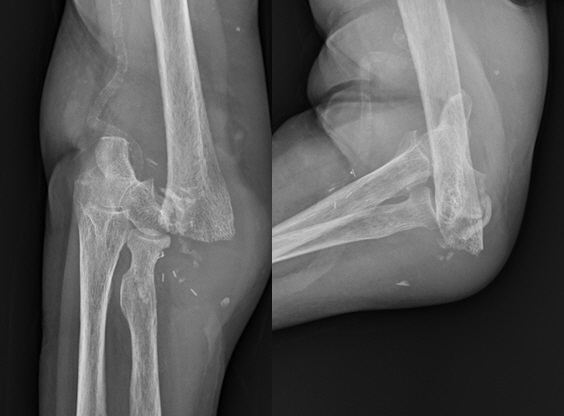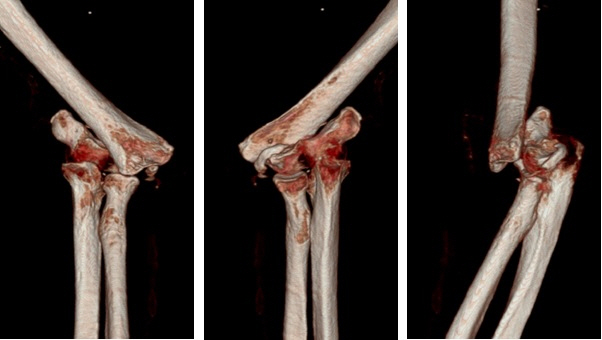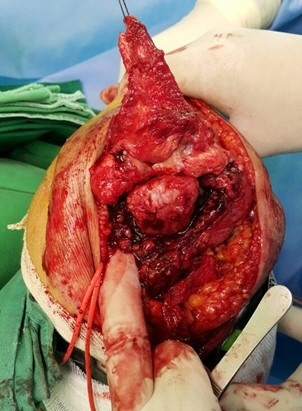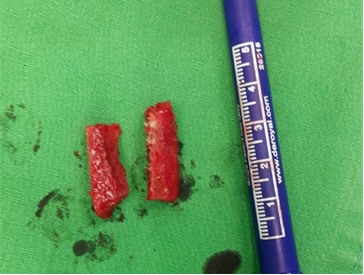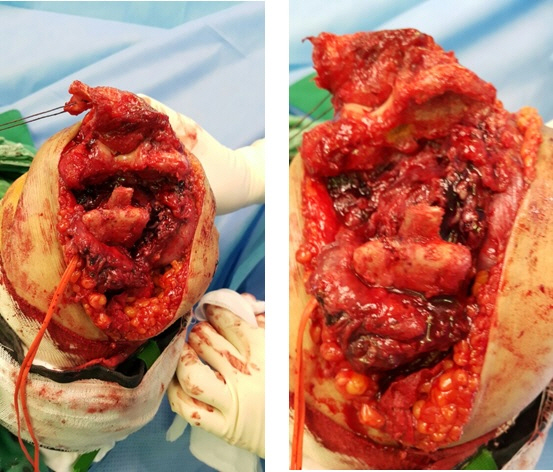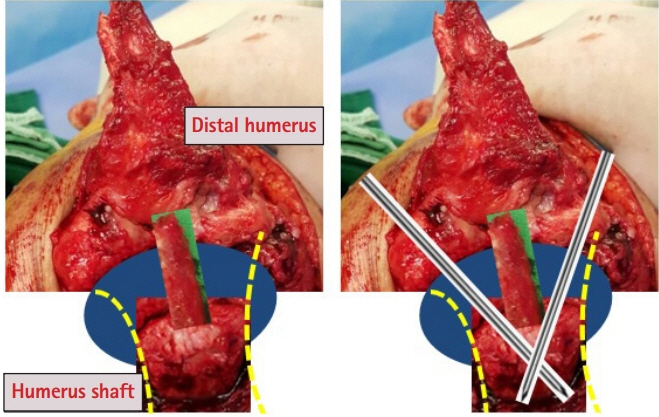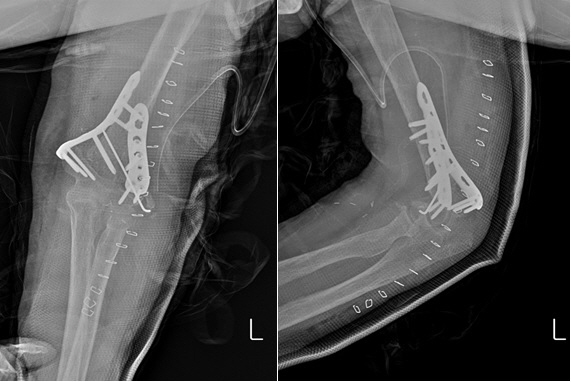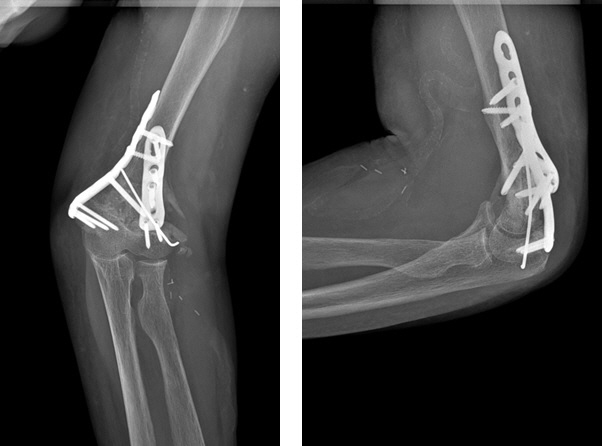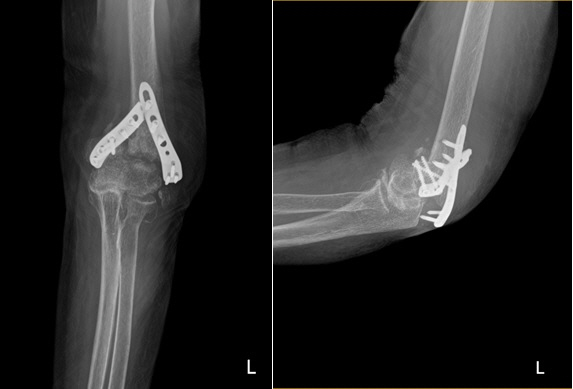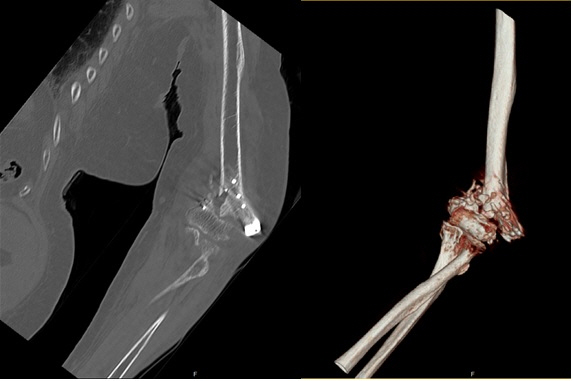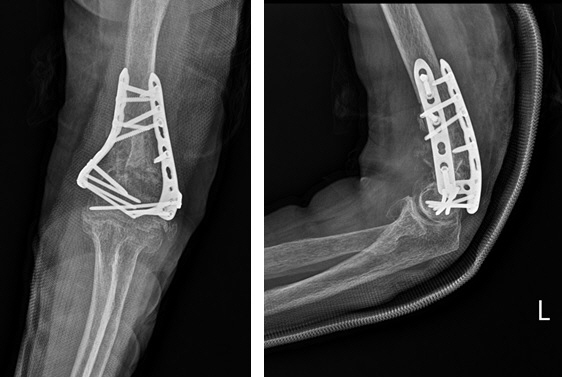Arch Hand Microsurg.
2020 Mar;25(1):39-45. 10.12790/ahm.19.0056.
Autogenous Inlay Bone Graft for Distal Humerus Nonunion with Metaphyseal Bone Defect: A Technical Note
- Affiliations
-
- 1Department of Orthopedic Surgery, Incheon St. Mary’s Hospital, College of Medicine, The Catholic University of Korea, Incheon, Korea
- KMID: 2501109
- DOI: http://doi.org/10.12790/ahm.19.0056
Abstract
- Distal humeral nonunion is one of the most concerned complications in elbow trauma. When bone loss at the fracture site is carried out due to nonunion, metaphyseal bone defect occurs. Therefore positioning of anatomical locking plate becomes difficult owing to abnormal bone contour, and fixation of small nonunion fragment is challenging. We introduce a good method of anatomical locking plate fixation with autogenous inlay strut bone graft for internal fixation. This technique is to insert autogenous inlay bone into the proximal medullary canal and hole of distal bone fragment which will lead to achieve correction of the anatomical alignment, length and rotation deformity. The inlay grafting is reduced to the shaft with two crossed K-wires temporarily. Definitive fixation is performed with locking plates, and autogenous bone graft is added at the defect site.
Keyword
Figure
Reference
-
References
1. Donders JC, Lorich DG, Helfet DL, Kloen P. Surgical technique: treatment of distal humerus nonunions. HSS J. 2017; 13:282–91.
Article2. Kim HS, Jang KJ, Choi YR, Koh IH, Kang HJ. Treatment of non-union distal humerus fractures after operation. J Korean Fract Soc. 2012; 25:310–6.
Article3. Ali A, Douglas H, Stanley D. Revision surgery for nonunion after early failure of fixation of fractures of the distal humerus. J Bone Joint Surg Br. 2005; 87:1107–10.
Article4. Beredjiklian PK, Hotchkiss RN, Athanasian EA, Ramsey ML, Katz MA. Recalcitrant nonunion of the distal humerus: treatment with free vascularized bone grafting. Clin Orthop Relat Res. 2005; (435):134–9.5. Allende C, Allende BT. Post-traumatic distal humerus non-union: open reduction and internal fixation: long-term results. Int Orthop. 2009; 33:1289–94.6. Gallay SH, McKee MD. Operative treatment of nonunions about the elbow. Clin Orthop Relat Res. 2000; (370):87–101.
Article7. Pugh DM, McKee MD. Advances in the management of humeral nonunion. J Am Acad Orthop Surg. 2003; 11:48–59.
Article8. Helfet DL, Kloen P, Anand N, Rosen HS. ORIF of delayed unions and nonunions of distal humeral fractures: surgical technique. J Bone Joint Surg Am. 2004; Mar. 86-A Suppl 1:18–29.9. LaPorte DM, Murphy MS, Moore JR. Distal humerus nonunion after failed internal fixation: reconstruction with total elbow arthroplasty. Am J Orthop (Belle Mead NJ). 2008; 37:531–4.10. Ring D, Gulotta L, Jupiter JB. Unstable nonunions of the distal part of the humerus. J Bone Joint Surg Am. 2003; 85:1040–6.
Article
- Full Text Links
- Actions
-
Cited
- CITED
-
- Close
- Share
- Similar articles
-
- A Novel Autogenous Iliac Bone Graft Technique for Distal Humeral Bone Loss in Revisional Total Elbow Arthroplasty: A Technical Note
- Compression Plate Fixation with Autogenous Bone Graft for Humerus Shaft Nonunion
- The Clinical Results in Compression Plate Fixation with Autogenous Cancellous Bone Graft for Humerus Diaphyseal Nonunion
- Nonunion of Humeral Intercondylar Comminuted Fracture Treated with Fibular Graft: A Case Report
- Infected Nonunion of Long Bones Treated with Dual Plate

